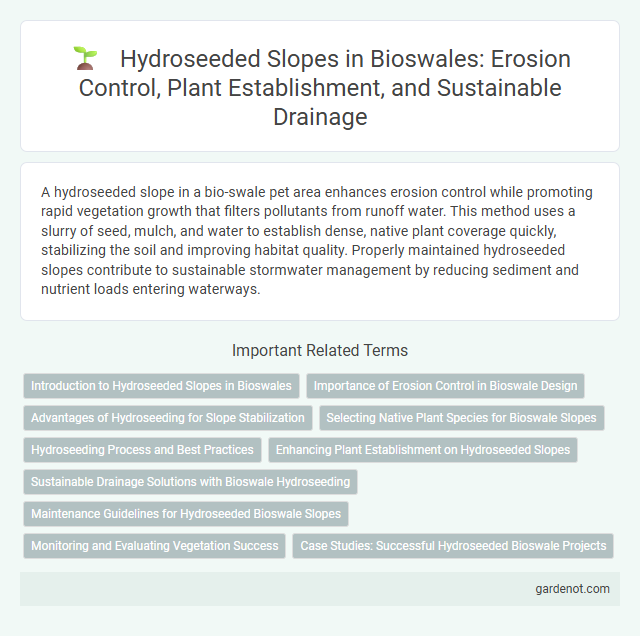A hydroseeded slope in a bio-swale pet area enhances erosion control while promoting rapid vegetation growth that filters pollutants from runoff water. This method uses a slurry of seed, mulch, and water to establish dense, native plant coverage quickly, stabilizing the soil and improving habitat quality. Properly maintained hydroseeded slopes contribute to sustainable stormwater management by reducing sediment and nutrient loads entering waterways.
Introduction to Hydroseeded Slopes in Bioswales
Hydroseeded slopes in bioswales utilize a specialized mixture of seed, mulch, fertilizer, and water applied through hydroseeding equipment to promote rapid vegetation growth and soil stabilization. This technique enhances erosion control, supports stormwater filtration, and increases the effectiveness of bioswales in managing urban runoff. By establishing dense root systems quickly, hydroseeded slopes improve slope integrity and contribute to sustainable landscaping practices in green infrastructure projects.
Importance of Erosion Control in Bioswale Design
Hydroseeded slopes in bioswale design play a critical role in controlling erosion by stabilizing soil through rapid vegetation establishment. Effective erosion control reduces sediment runoff, improves water quality, and enhances the bioswale's capacity to manage stormwater sustainably. Incorporating hydroseeding techniques ensures consistent vegetation coverage, minimizing soil displacement and maintaining the structural integrity of bioswale systems.
Advantages of Hydroseeding for Slope Stabilization
Hydroseeding offers rapid vegetation establishment on slopes, significantly reducing erosion risks through dense root development. The method ensures even seed distribution and moisture retention, promoting consistent plant growth on challenging terrains. Cost-effective and efficient, hydroseeding stabilizes soil quickly, enhancing slope durability during heavy rainfall and runoff events.
Selecting Native Plant Species for Bioswale Slopes
Selecting native plant species for bioswale hydroseeded slopes enhances soil stabilization and improves water filtration by leveraging deep-rooted, drought-tolerant vegetation specifically adapted to local climate conditions. Native plants such as switchgrass (Panicum virgatum), blue wildrye (Elymus glaucus), and California fescue (Festuca californica) provide robust erosion control while supporting local biodiversity and minimizing irrigation needs. Using a diverse mix of native grasses, sedges, and wildflowers ensures resilience against seasonal fluctuations and promotes healthy microbial activity in bioswale ecosystems.
Hydroseeding Process and Best Practices
Hydroseeding a bio-swale slope involves spraying a slurry mix of seeds, mulch, fertilizer, and water to promote rapid vegetation establishment and soil stabilization. Key best practices include selecting native or site-appropriate seed varieties, ensuring uniform application for full slope coverage, and using erosion control additives like tackifiers to prevent washout on steep gradients. Proper timing during optimal weather conditions and consistent post-application irrigation are critical to maximize germination rates and long-term bio-swale functionality.
Enhancing Plant Establishment on Hydroseeded Slopes
Hydroseeded slopes benefit significantly from bio-swales, which aid in managing stormwater runoff and reducing soil erosion, thereby enhancing plant establishment and growth. The bio-swale's ability to retain moisture ensures consistent hydration for seeds, promoting faster germination and robust root development. Integrating bio-swales with hydroseeding techniques optimizes slope stability and vegetation density, contributing to long-term ecological restoration.
Sustainable Drainage Solutions with Bioswale Hydroseeding
Hydroseeded slopes integrated with bioswale technology enhance sustainable drainage solutions by stabilizing soil and promoting efficient water infiltration. This method reduces runoff volume and pollutants, mitigating erosion and improving groundwater recharge. Utilizing native vegetation in bioswale hydroseeding supports biodiversity while managing stormwater sustainably.
Maintenance Guidelines for Hydroseeded Bioswale Slopes
Proper maintenance of hydroseeded bioswale slopes includes regular inspection for erosion, patching bare areas promptly, and ensuring consistent moisture during the establishment period. Mowing should be performed at recommended heights to prevent damage to young vegetation while promoting healthy growth and weed control. Nutrient management through periodic fertilization supports robust plant establishment, enhancing the bioswale's efficiency in stormwater filtration and sediment retention.
Monitoring and Evaluating Vegetation Success
Monitoring and evaluating vegetation success on hydroseeded slopes involves regular assessments of plant coverage, species diversity, and soil stabilization effectiveness within the bio-swale. Utilizing remote sensing technologies and on-site inspections enables accurate measurement of growth rates and early detection of erosion or invasive species. Consistent data collection supports adaptive management strategies that enhance slope resilience and ecological function over time.
Case Studies: Successful Hydroseeded Bioswale Projects
Hydroseeded bioswale projects have demonstrated effective erosion control and enhanced stormwater management in urban and suburban environments. Case studies reveal significant reductions in sediment runoff and improved vegetation establishment within weeks, contributing to sustainable landscape solutions. Successful implementations in regions like California and Texas highlight adaptive plant mixes and soil amendments tailored to local climates, ensuring long-term durability and ecological benefits.
Hydroseeded slope Infographic

 gardenot.com
gardenot.com